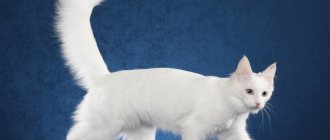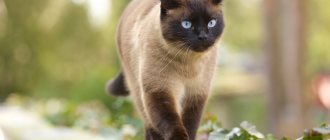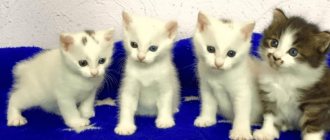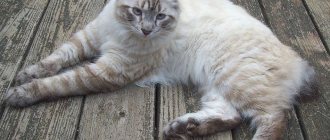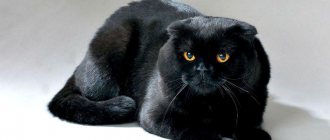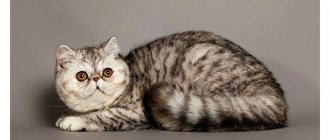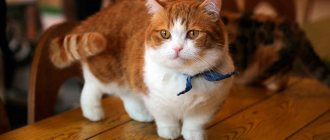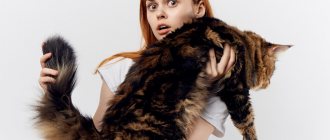British cats are one of the most sought after pets. Not only shorthaired cats have gained worldwide popularity, but also their furry relatives - British Longhairs, or Highlanders. A cute face, thick, long hair with a fluffy tail and a golden cat character are three reasons to fall in love with this breed.
Brief history of the breed
Work on breeding Highlanders began in 1993, when breeders decided to improve the already existing Desert Lynx cat variety. To make their ears curled, experts used representatives of the new hybrid breed Jungle Curl (obtained by crossing Bengals, Serengeti, Egyptian Mau, American Curls, Chausie, etc.).
As a result, the breeders managed to fix the folded ears while maintaining the spotted lynx coloring. In May 2008, the Highlander cat breed received recognition from TICA, and since 2016 it can be exhibited in the Advanced new breed class.
Read more - “About different breeds of cats with curled ears.”
History of British Longhair cats
The past of the Lowlanders cannot be called ancient, much less glorious.
The breed arose due to a recessive gene for long hair, the carriers of which, according to felinologists, should not have been allowed to reproduce. Moreover, the breeders themselves were to blame for the genetic failure; in the mid-50s they wanted to expand the color palette of British shorthairs by crossing them with Persians. At first, everything went according to plan: kittens born from mixed “marriages” inherited the luxurious colors of Persian cats and the short hair of their English parents. However, after several generations, the “increased fluffiness gene” made itself felt, and the animals began to bear long-haired offspring. Breeders were not prepared for such a surprise, so at first they strictly rejected fluffy kittens, selling them for a symbolic price, or even for free, provided that no one would breed such pets.
Soon, the longhaired variation of the British found a few fans who began to “push” the breed into the TICA and WCF breeding lists. But since the British cats were distinguished from their English ancestors only by their voluminous fur coats and nothing more, some felinological clubs in Europe and the USA continued to register them as a variety of British cats. At the same time, TICA recognizes Lowlanders, although for now in the status of a new breed.
Important: today, crossing Persians with British shorthair and longhair cats is prohibited. At the same time, matings between Lowlanders and traditional British are allowed by some clubs.
Interesting Facts
Although the Highlanders do not have a rich history, many interesting things have been associated with them:
- The name of the breed Highland Lynx translates as “mountain lynx”. And in some sources these cats are referred to as shorthaired Highlanders.
- Due to the similar name, representatives of the breed are often confused with Highland Folds. But they are in no way related to the British and Scottish Longhairs.
- Formally, Highland Links can be considered hybrids. But the percentage of wild blood present in them is so small that it does not affect anything at all. Therefore, genetically, Highlanders are completely domestic cats that do not pose a threat to people.
Origin
The ancestor of this breed is considered to be the “mountain lynx”.
The cat breed was bred in 2004. English breeders made a unanimous decision to introduce to the world a new breed, similar in appearance to a wild lynx. The “mountain lynx” was taken as the basis. It does not belong to wild cats, and does not contain wild genes in its own genus. The crossing was pure, without the use of hybrids. To breed cats with the desired appearance, breeders selected pets with the required coat color. The experiment was a success and the result was a small domestic lynx, but completely harmless, gentle and friendly. The new breed is nicknamed Highland Lynx, which translates to “mountain lynx.” Received official recognition in 2005.
Behavior and character
The Highlander cat is a wonderful choice of pet. They have a friendly and calm disposition. In the presence of strangers, the pet does not hide, but enjoys contacting them. Cats do not prefer to make sounds; they tend to show their own opinions through gestures and touches. They get along easily with kids and other pets. Due to its calm nature, conflicts are excluded. But you need to carefully consider the situation, if there are rodents and birds in the house, the instincts are not canceled. To eliminate the possibility of tragedy, owners need to closely monitor their pets when they are in the same room.
Health and illness
Tartar is one of the few pathologies to which these pets are susceptible.
Highlander cats are a strong and resilient breed, but are prone to certain diseases. Heart disease can be inherited genetically. Like other breeds with a short muzzle, the animals are predisposed to the formation of tartar. It is necessary to systematically examine the cat’s oral cavity and monitor the cleanliness of the teeth. Representatives of the breed also have problems with obesity and suffer from allergic reactions. It is necessary to vaccinate cats according to the vaccination schedule.
Nutritional Features
The cat breed is large in size and does not complain about its appetite. In nutrition, it is necessary to adhere to generally accepted standards, and not give students the opportunity to overeat. Excess food threatens obesity, and as a result, leads to many problems with well-being. When selecting dry food, preference should be given to premium products, in addition. It is possible to dilute the diet with pates and canned food of similar labeling. With a natural diet, you need to give cats a complex of vitamins. The basis should be meat and meat by-products - rabbit, chicken, beef, pork, chicken liver, heart, ventricles. It is recommended to boil the products before use; if served raw, you must first scald them with boiling water. In addition to food, animals need fresh drinking water.
Breed description, standards, appearance
Highlanders are muscular, compact cats with short tails and ears turned outward. Outwardly, they resemble strong and agile lynxes.
Dimensions and weight
Highlanders are fairly large cats with pronounced sexual dimorphism. The average weight of a female is 4.5-6.5 kg. The weight of a male Highland Lynx varies between 6.5-9 kg.
Anatomical characteristics
A typical Highlander cat should fit the following description:
- The head is triangular, with rounded cheekbones, a convex skull, a high forehead, a short blunt muzzle, pronounced whisker pads and a wide nose.
- The eyes are almond-shaped, medium-sized, slanting, widely set. The iris of the Highland Lynx can be green, orange or yellow.
- The ears are medium in size, with a wide base and flexible, curved back tips.
- The body is rectangular in shape, with a straight back, slightly raised croup and well-developed muscles.
- The limbs are of medium length, with rounded paws and pronounced knuckles.
- The tail is thick and short. Its length in Highland Links should not be less than 2.5 cm and longer than the hock joints.
On a note. The Highlander is one of the few breeds in which polydactyly is acceptable.
Color and coat type
The body of the Highland Lynx is covered with beautiful fur, the texture of which depends on the length and color. A cat of this breed is:
- shorthair - with a thick coat and dense undercoat;
- long-haired - with developed decorative hair, which, as it were, forms trousers and a frill.
According to the Highland Lynx breed standard, spotted, marbled or striped tabbies in any color combination are allowed.
On a note. The color of the Highlander's coat is determined by the tone of the undercoat. For example, if a cat's fur appears to be silver-black and her underpads are brown, then her color would be considered brown.
Possible breed defects
Exterior defects, the presence of which reduces the breeding value of the Highland Links:
- weak bones;
- the tail is shorter than 2.5 cm and longer than the hocks;
- ears are bent more than 90 degrees.
Standard according to WCF version
Just a few years ago, the Scottish Fold Highland Fold was a rare occurrence in litters when two Scottish Shorthairs were mated. Now, many breeders are engaged in their breeding, who strive to preserve it.
Upon external examination, the presence of Persian blood becomes obvious - the eyes are close-set, the profile is smoothed, the coat is very soft.
According to the WCF standard, the Scottish Highland Fold must have a proportional body that is rounded and ends in a long tail.
It is very important that the tail is flexible, otherwise it will be considered a defect.
Their paws are round and their head is rounded. One of the distinctive features is the strong-willed chin and shortened nose.
The eyes are large and widely spaced. The Scottish Fold has a very dense and long coat that comes in different shades. Over time, it may become a little weak, but this should not be allowed, since according to the standard this will already be a drawback, albeit a small one.
Ears are pressed tightly to the head and directed downwards. They have several folds that make them stand out from other breeds. The number of folds affects the degree of curvature of the ear. So, in the third degree, the ear is pressed tightly.
The resulting estimates largely depend on the quantity and quality of such folds, because they are one of the indicators of this type. This breed can get the maximum number of points for its ears and tail. Therefore, you must carefully examine the kitten before picking it up from the breeder. In this case, the ears and tail are especially carefully checked.
Determination of purebredness occurs already in the third week after birth, when the kittens’ ears begin to curl.
A cat whose tail is found to have a hook on it or whose tail is too short and inactive will be disqualified. Also, abnormal bone changes and an unusual number of toes are not allowed. And the presence of diseases can often be one of the main reasons for the disqualification of a Highland
That is why it is important to carefully monitor his condition and feed him adequately.
Be careful even at the stage of choosing a kitten, because a thorough examination will allow you to choose a baby with good health and prevent many problems in the future. If you are a beginner and are not very well versed in all the features, then it is advisable to consult with a more experienced breeder in advance or read the relevant literature.
Character and temperament
The Highlander is a cat with a friendly and gentle disposition. He likes to be the center of everyone's attention, and he achieves this through funny pranks.
The curious Highland Lynx explores new places with the enthusiasm of a true explorer, but does not go on a “race” through curtains and closets.
On a note. Highlanders are not particularly talkative. To express emotions, representatives of the breed prefer to use tail wagging or an ingratiating look into the eyes of their owners.
The friendly nature of Highlanders allows them to easily find a common language with children. Non-jealous and calm cats never respond with aggression to childish pranks. Highland Links also easily get along with other pets and get along peacefully with all animals, including rodents, reptiles and birds.
Personality of the British Longhair cat
The longhaired British cat is the embodiment of delicacy and peacefulness itself. Actually, for these character traits alone, representatives of the breed can be recommended to owners who want to have a problem-free pet next to them, to whose whims they do not have to adapt. Lowlanders are extremely moderate in their preferences and do not cross the line beyond which misunderstandings and friction with the owner begin. For example, furry intellectuals adore human company, but in his absence they do not fall into depression, preferring to quietly philosophize on their favorite couch or armchair. By the way, breeders who have many years of experience in breeding the breed claim that the character of their charges is more docile and good-natured than that of short-haired British cats.
Kittens also experience attacks of mild melancholy, during which they are reluctant to contact the owner and members of his family. During such periods, it is better not to pester your pet, giving him the opportunity to take a slight break from communication - don’t worry, this withdrawal will not last long. Morning oratorios while waiting for breakfast are also not about the British. From time to time, English “gentlemen” are able to remind themselves with a quiet, slightly rolling “meow”, but they certainly will not scream to attract attention or in confusion of feelings.
But the long-haired Briton will not refuse to play, and this comrade perceives with equal delight both entertainment in the company of a person and the independent “torment” of a wind-up mouse or ball. As they grow up, British Longhairs become more phlegmatic and slow down in terms of physical activity, so anyone who is scared of hurricane cats, dashingly diving from the closet to the sofa and overturning flower pots of any weight, can get such a pet.
Purrs treat children patiently and condescendingly, provided that the latter do not annoy the animal too much with their attention. When bringing a British Longhair cat into your home, inform your children that the breed does not like strong hugs, nor does it like a noisy, nervous environment. We are ready to tolerate lowlanders and the presence of dogs. True, in order for the relationship between the dog and the representative of the purring brethren to become extremely peaceful, it is better that acquaintance and getting used to each other take place at a young age.
How to choose the right kitten
The Highlander is an expensive and rare breed of cat. Leading breeders specializing in breeding such animals live in the United States. Therefore, you will most likely have to choose a Highland Lynx kitten in absentia. In this case, it is advisable to focus on the following criteria:
- availability of pedigree and veterinary passport;
- conditions of detention;
- behavioral characteristics;
- compliance with the breed standard;
- health status.
On a note. Highlander kittens are born straight-eared. As they grow, the tips of their ears curl back.
Choosing a kitten and its price
The longhaired British breed has many fans, so getting a kitten will not be a problem. Please note that the price of a cat is always cheaper than a cat. Also, the cost will depend on the color, purity of the pedigree (presence of Persians), and the status of the nursery. Kittens with appropriate documentation are more expensive.
There is a division into classes: show, breed and pet. Exhibition representatives are more expensive than usual, their price starts from 15,000 rubles. An ordinary kitten for home can be found through private advertisements from 3,000 rubles. Be careful when choosing and beware of scammers. Look at the parents and the rest of the kittens. Make sure you are paying for a British Longhair and not just a fluffy kitten.
Care and maintenance
Unpretentious Highland Links are able to quickly adapt to any conditions. They live in apartments and private houses without any problems. Caring for Highlanders includes a number of standard procedures:
- The eyes and ears of cats are regularly examined for the presence of nonspecific discharge and wiped with cotton pads soaked in alcohol-free products.
- Highlanders' claws grow very quickly and break off. Therefore, they are systematically shortened with a nail cutter so as not to affect the blood vessels. And to prevent cats from tearing wallpaper and upholstered furniture, they are provided with scratching posts.
- Highlanders' teeth are brushed several times a week with a non-foaming paste using a special silicone brush or soft brush.
- Cats of this breed are bathed 3-4 times a year or as needed. Bath procedures are carried out in warm rooms where there are no drafts. And for washing they use special shampoos.
- Long-haired Highland Links require careful grooming. They are systematically combed out with a slicker brush or a brush with soft bristles. The hair of shorthaired Highlanders is treated several times a week with a special glove.
Pet care
Remember that this breed loves a clean house and the availability of delicious food. That is why the owner must always monitor and maintain order, as well as provide the pet with uninterrupted access to clean drinking water.
It is very important that the diet is balanced, and sometimes it is worth giving them a mineral and vitamin complex. Thanks to this he will be healthy and active
A day is enough to accustom a Scot to the tray. After he learns to go to the toilet in the right place, make sure that it is always clean. Innate cleanliness will not allow him to go to the dirty toilet, and he will begin to look for another place for this.
Although these cats have long hair, they do not require special conditions, and caring for them does not take much time. The structure of the wool is unusual, so it will never get tangled.
Of course, in appearance cats are very similar to Persian cats, but there are much fewer worries with them. Brush them every week with a special comb. It is advisable to immediately buy two different brushes for deep combing and light massage. Thanks to this, your pet will always remain clean and beautiful.
You can bathe them once a month and only if the pet has managed to get dirty with something. Otherwise, bathing can be postponed for another month, because it is harmful for animals to be in water often.
Don’t forget to clean your pet’s ears with cotton swabs and trim his nails every 2 weeks. But you should be extremely careful, because Highland ears are very fragile.
You need to visit special salons or veterinary clinics, where grooming will be carried out by a professional master. This will not only save the cat from suffering in hot summer weather, but also diversify its appearance with fancy drawings and inscriptions. But you shouldn’t try to do it yourself at home with ordinary scissors, because grooming a cat requires the use of special professional equipment and a certain groomer’s experience. By contacting the salon, you can be sure of an excellent final result and that the cat will not suffer from such a procedure.
Scottish Folds rarely get sick
They are in good health from birth, although they must carefully monitor their diet and regularly receive all necessary vaccinations. Also, it wouldn’t hurt to periodically add vitamin and mineral supplements to your food to improve your health, coat, and strengthen your immune system.
Health problems are evidence of improper breeding, care and nutrition. That is why choose a kitten very carefully.
If your pet gets sick or starts behaving strangely, you should immediately contact a veterinarian. They will prescribe effective treatment.
Feeding the cat
Highlanders are active cats with an excellent appetite. They happily eat both industrial and natural food. Therefore, when choosing a diet, you can be guided by your own preferences.
With an industrial type of nutrition, Highland Links buy premium or super-premium food with a complete, well-balanced composition. The following brands of drying are perfect for cats of this breed:
- Acana;
- Bosch;
- Brit Care;
- Pronature.
Important! Highlanders, whose diet is based on dry food, should have free access to fresh drinking water.
With a natural type of nutrition, the menu of cats of this breed should be dominated by protein foods in the form of raw chicken, turkey, lean beef or rabbit meat. Several times a week, meat can be replaced with boiled offal and ocean fish. It is also recommended to include porridge, quail eggs, fermented milk products and vegetables in the diet of Highland Links.
To maintain normal functioning of the gastrointestinal tract, fatty meat, river fish, bones, potatoes, milk, sausages, pickles, confectionery and any food from the owner's table are excluded from the menu of these cats.
On a note. With a natural diet, mineral supplements are introduced into the Highlanders’ diet twice a year, which are selected after consultation with a veterinarian.
Life of a long-tailed cat in captivity
Margai is a wild beast, although he has a cute appearance. Such animals have clearly developed appropriate behavior, so they are not adapted to home life. Any small animal in the house will definitely become margay’s prey. Even a small dog can suffer from the claws and teeth of a wild cat. Therefore, representatives of the species living in captivity can be found in zoos.
To properly raise a margay, it must be adopted at an early age.
Features of caring for a predator
Of course, the main requirements for keeping a wild cat are safety measures. All windows and doors must be protected with metal mesh. This will protect not only the owner of the house and his children, but also the cat itself. The animal may leave home and not return. If we are talking about cool regions of Russia, then the animal faces almost one hundred percent death from hypothermia in the first autumn. If we are talking about a relatively warm and humid climate, then in the courtyard of the house you can install a special enclosure covered with a high mesh. However, even in such an enclosure you need a warm house for the cat. In the absence of a house, the cat will have to be brought home at night.
If margay is raised correctly, he can go into your arms
Such a cat needs to be fed meat with small bones (beef, chicken, feed mice and offal). Such food is very similar to prey that a cat could catch in the wild. In addition, the cat needs to be given vitamins and special supplements. Usually people who dare to purchase such an exotic pet communicate closely with veterinarians. Only special skills and knowledge of animal medicine will allow you to raise and educate a wonderful cat.
Video: Margay named Maya eats meat
There have been cases when long-tailed cats lived their entire lives next to humans. True, the behavior of such an animal is more similar to the behavior of a dog. A tamed margay fussily stomps on its owner’s chest and licks his face. I heard that wild cats can even protect their owner and growl at offenders if there is any threat from them.
Education and physical activity
Highland Lynx cats are energetic and temperamental cats. To maintain muscle tone and good physical shape, they need a lot of exercise. If desired, Highlanders can be easily trained to walk on a harness. If this is not possible, they will set up a sports corner for the cat at home and buy several different toys.
Highland Links are endowed with high intelligence and excellent memory. Despite their wild appearance and penchant for mischief, cats of this breed are easy to train and, like dogs, remember simple commands.
On a note. In order not to spoil the pet and prevent undesirable behavior from becoming established, the little Highlander is taught order from the very first days.
Health and susceptibility to disease
Highlanders are strong and hardy cats with good heredity. Under favorable conditions, they live up to 14-16 years.
Despite good immunity, representatives of the breed are prone to the following diseases:
- obesity;
- allergy;
- hypertrophic cardiomyopathy.
In addition to specific pathologies, Highland Links are prone to standard feline infections. Therefore, they are required to undergo routine preventive vaccination and antiparasitic treatment.
Health
In general, cats have good psychological and physical health. Cats are not prone to diseases, but regular examination is recommended. The British Longhair is classified as a short-faced cat, and they can develop tartar. Keep your animal's mouth clean. Carry out vaccinations, treatment against parasites and deworming in a timely manner. Some pets may suffer from allergies and obesity. If you see weight and body gain, increase your mobility through active play. Perhaps you should adjust your diet and switch to a lower calorie diet.
The only thing that the breed has is a hereditary disease – hypertrophic cardiomyopathy. It can be determined by performing an ultrasound of the heart. The disease has no cure, but is not fatal either. With the right regimen, your pet will be with you for a long time.
Thanks to strong immunity from birth and your care, long-haired British representatives can live up to 20 years.
Pros and cons of the breed
Since Highland Links are not cheap, before buying a kitten you should analyze all the advantages and disadvantages of this breed:
| pros | Minuses |
| Cute appearance | The high cost of kittens |
| Low maintenance | Small number of nurseries |
| High intelligence |
Highlanders are beautiful short-tailed cats with original colors and unusual ears turned back. Their wild appearance is successfully complemented by a friendly and sociable disposition, which makes them an object of interest for many exotic lovers.

